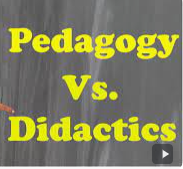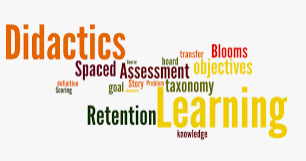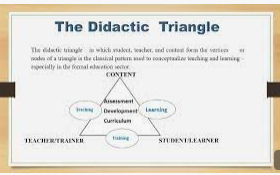Différences entre versions de « Didactics »
| Ligne 136 : | Ligne 136 : | ||
<!-- ****************** Commercez les modifications *********************** --> | <!-- ****************** Commercez les modifications *********************** --> | ||
| − | *........... | + | * Lesson Planning: Didactics provides a framework for designing and planning effective lessons. Teachers use didactic principles to structure their lessons, set clear learning objectives, select appropriate teaching methods and resources, and design engaging activities that facilitate student understanding and achievement. |
| − | + | ||
| − | . | + | * Differentiated Instruction: Didactics supports the application of differentiated instruction, which involves tailoring instruction to meet the diverse needs, interests, and abilities of students. Teachers use various strategies, such as flexible grouping, varied instructional materials, and individualized assessments, to ensure that all students can access and engage with the curriculum. |
| − | + | ||
| − | *.. | + | * Use of Educational Technologies: Didactics guides the integration of educational technologies into teaching and learning. Teachers can use digital tools, multimedia resources, online platforms, and interactive software to enhance instruction, promote active engagement, and provide personalized learning experiences. |
| − | . | + | |
| − | + | * Project-Based Learning: Didactics can be applied in project-based learning approaches, where students engage in authentic, real-world projects to explore and apply knowledge. Teachers design projects that align with learning goals, promote inquiry, critical thinking, collaboration, and self-directed learning, allowing students to actively construct knowledge. | |
| − | . | + | |
| + | * Assessment Strategies: Didactics provides guidance for selecting and implementing effective assessment strategies. Teachers use a variety of formative and summative assessment methods, such as quizzes, portfolios, presentations, and performance tasks, to monitor student progress, provide feedback, and evaluate learning outcomes. | ||
| + | |||
| + | * Cooperative Learning: Didactics supports the use of cooperative learning approaches, where students work together in small groups to achieve learning goals. Teachers structure cooperative tasks, promote positive interdependence, and provide opportunities for students to engage in collaborative problem-solving, discussion, and peer learning. | ||
| + | |||
| + | * Inquiry-Based Learning: Didactics is applied in inquiry-based learning, where students actively explore topics, generate questions, and conduct investigations to develop a deep understanding of concepts. Teachers facilitate the inquiry process, provide guidance, and encourage critical thinking, problem-solving, and self-directed learning. | ||
| + | |||
| + | * Professional Development: Didactics informs professional development programs for teachers. Through workshops, seminars, and ongoing support, teachers can enhance their knowledge of didactic principles, learn new instructional strategies, and refine their teaching practices to improve student learning outcomes. | ||
| + | |||
| + | * Curriculum Development: Didactics guides the development and revision of curriculum frameworks and educational standards. It ensures that the curriculum is aligned with educational goals, incorporates effective teaching and learning strategies, and provides a coherent and meaningful learning progression for students. | ||
| + | |||
| + | * Reflective Teaching Practice: Didactics encourages teachers to engage in reflective practice, where they critically analyze their teaching approaches, reflect on student learning outcomes, and make adjustments based on feedback and evidence. Reflective practice helps teachers continuously improve their instructional practices and enhance student learning. | ||
}}<!--************** Fin Fiche Didactique Explicitations ******************* --> | }}<!--************** Fin Fiche Didactique Explicitations ******************* --> | ||
| − | |||
= {{Widget:Erreurs-confusions-Fiche}} = | = {{Widget:Erreurs-confusions-Fiche}} = | ||
Version du 23 mai 2023 à 19:46
 Traduction
Traduction
 Définition
Définition
Domaine, Discipline, Thématique
Définition écrite
- Didactics is the art of teaching. It’s the study of how to teach, and it’s also the philosophy of education. It focuses on four main areas: learning, teaching, research and evaluation.
In addition, it can be divided into two categories: theoretical and practical didactics.
Theoretical didactics are used to study how people learn, and how they can be taught more effectively, while practical didactics focus on teaching methods based on this research.
- Didactics can also be defined as the science of teaching and learning. She is interested in how knowledge, skills and values are transmitted and acquired, and the methods, tools and techniques that facilitate this process.
Didactics is therefore concerned with all aspects of teaching, from the planning of courses to the implementation of pedagogical activities, including the evaluation of learning. It takes into account the characteristics of learners (age, level, learning style, etc.) and the constraints of the educational context (curriculum, resources, etc.).
Didactics can be applied to all areas of knowledge and all levels of education, from kindergarten to university to vocational training. It draws on research in educational sciences, learning psychology, educational sociology, disciplinary didactics, etc. to develop effective pedagogical approaches adapted to the needs of learners.
....................................................................... ....................................................................... .......................................................................
....................................................................... ....................................................................... |
Définition graphique
 Concepts ou notions associés
Concepts ou notions associés
 Exemples, applications, utilisations
Exemples, applications, utilisations
|
 Erreurs ou confusions éventuelles
Erreurs ou confusions éventuelles
- .........................................
- .........................................
![]() Confusion possible ou glissement de sens
Confusion possible ou glissement de sens
- Confusion entre conceptions - representation
- Confusion entre ....... - ........
- ....................
 Questions possibles
Questions possibles
 Liaisons enseignements et programmes
Liaisons enseignements et programmes
Idées ou Réflexions liées à son enseignement
Aides et astuces
Education: Autres liens, sites ou portails
 Bibliographie
Bibliographie
Pour citer cette page: ([1])
ABROUGUI, M & al, 2023. Didactics. In Didaquest [en ligne]. <http:www.didaquest.org/wiki/Didactics>, consulté le 24, novembre, 2024
- ..................
- ..................
- ..................
- ..................
- Sponsors Education
- Didactics and Pedagogy (Concepts)
- Didactics and Constructivism (Concepts)
- The Didactic Triangle (Concepts)
- Didactic Transposition (Concepts)
- Conceptions and Representations (Concepts)
- Didactic Obstacles (Concepts)
- The Didactic Contract (Concepts)
- Perverse Effects of the Didactic Contract (Concepts)
- Teaching and Learning
- Curriculum
- Instructional Design
- Pedagogical Approaches
- Assessment
- Differentiation
- Motivation
- Learning Environment
- Teacher-Student Interaction
- Reflective Practice
- Concepts
- Didactics
- Didactics (Concepts)
- Fiche conceptuelle didactique





